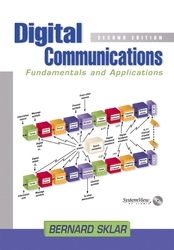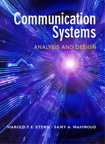Digital Transmission Systems, 3/e
David R. Smith
- 出版商: KAP
- 出版日期: 2003-11-30
- 售價: $1,350
- 貴賓價: 9.8 折 $1,323
- 語言: 英文
- 頁數: 808
- 裝訂: Hardcover
- ISBN: 1402075871
- ISBN-13: 9781402075872
下單後立即進貨 (約5~7天)
買這商品的人也買了...
-
 精通 Vi (Learning the Vi Editor, 6/e)
精通 Vi (Learning the Vi Editor, 6/e)$550$435 -
 精通 Visual Basic.NET 中文版黑皮書 (Visual Basic.NET Black Book)
精通 Visual Basic.NET 中文版黑皮書 (Visual Basic.NET Black Book)$750$585 -
 Microsoft Windows Server 2003 系統實務
Microsoft Windows Server 2003 系統實務$780$616 -
 鳥哥的 Linux 私房菜-伺服器架設篇
鳥哥的 Linux 私房菜-伺服器架設篇$750$638 -
 鳥哥的 Linux 私房菜─基礎學習篇增訂版
鳥哥的 Linux 私房菜─基礎學習篇增訂版$560$476 -
 Project 2003 徹底研究
Project 2003 徹底研究$690$538 -
 Windows CE.NET 程式設計 (Programming Microsoft Windows CE .Net, 3/e)
Windows CE.NET 程式設計 (Programming Microsoft Windows CE .Net, 3/e)$890$703 -
 $1,742Linux Device Drivers, 3/e (Paperback)
$1,742Linux Device Drivers, 3/e (Paperback) -
 Linux iptables 技術實務─防火牆、頻寬管理、連線管制
Linux iptables 技術實務─防火牆、頻寬管理、連線管制$620$490 -
 Oracle Database 10g DBA 技術手冊 (Oracle Database 10g DBA Handbook)
Oracle Database 10g DBA 技術手冊 (Oracle Database 10g DBA Handbook)$990$842 -
 最新詳解 Javascript & HTML & CSS 語法辭典(增訂新版)
最新詳解 Javascript & HTML & CSS 語法辭典(增訂新版)$490$382 -
 深入淺出 Java 程式設計, 2/e (Head First Java, 2/e)
深入淺出 Java 程式設計, 2/e (Head First Java, 2/e)$880$695 -
 程式保護與破解 SoftICE 使用實例
程式保護與破解 SoftICE 使用實例$600$540 -
 Linux Mail Server 技術實務─架設、稽核、防毒、防垃圾信
Linux Mail Server 技術實務─架設、稽核、防毒、防垃圾信$580$458 -
 軟體預先架構之美學 (Prefactoring)
軟體預先架構之美學 (Prefactoring)$580$458 -
 深入淺出 Hibernate
深入淺出 Hibernate$650$507 -
 SQL Server 2005 資料庫開發聖經
SQL Server 2005 資料庫開發聖經$890$757 -
 駭客與畫家-電腦世紀的大觀念 (Hackers and Painters: Big Ideas from the Computer Age)
駭客與畫家-電腦世紀的大觀念 (Hackers and Painters: Big Ideas from the Computer Age)$300$237 -
 ASP.NET 2.0 網頁製作徹底研究, 2/e
ASP.NET 2.0 網頁製作徹底研究, 2/e$660$521 -
 Microsoft SQL Server 2005 設計實務
Microsoft SQL Server 2005 設計實務$680$537 -
 Visual Basic 2005 程式開發與介面設計秘訣
Visual Basic 2005 程式開發與介面設計秘訣$720$569 -
 配色王-最能激發創意與觸動人心的配色技法
配色王-最能激發創意與觸動人心的配色技法$360$281 -
 ASP.NET 2.0 程式設計
ASP.NET 2.0 程式設計$650$553 -
 專案管理之美學 (The Art of Project Management)
專案管理之美學 (The Art of Project Management)$620$490 -
 Ajax 網頁程式設計─Google 成功背後的技術
Ajax 網頁程式設計─Google 成功背後的技術$580$458
商品描述
Description:
Digital Transmission Systems, Third Edition, is a comprehensive overview of the theory and practices of digital transmission systems used in digital communication. This new edition has been completely updated to include the latest technologies and newest techniques in the transmission of digitized information as well as coverage of digital transmission design, implementation and testing.
Highlights of this edition:-New material on error correction codes, multiple access, digital modulation, digital subscriber lines, cable modems, mobile wireless, wide area networks, and optical networks;
-Up-to-date industry standards and practices - including voice/video coding, digital subscriber lines, SONET/SDH, DWDM, ATM, broadband wireless access, network synchronization, and network management - are described and interpreted;
-Expanded problem sets (totaling over 300) at the end of each chapter for review and practice;
-All chapters have been updated with particular emphasis given to fiber optics, wireless and networks.The book is heavily illustrated with tables, figures and an abundance of examples and references to actual systems. Examples are from common carriers, manufacturers and the author's commercial experience. Telecommunications terms are defined and explained when first introduced.
Practicing engineers in the field of communication systems, managers and technical personnel in the IT industry, and students of electrical and communications engineering will find this an authoritative state-of-the-art resource.
Table of Contents:
Preface. Acknowledgement.
1: Introduction to Digital Transmission Systems. 1.1. Historical Background. 1.2. Present-Day Digital Transmission. 1.3. Digital Transmission Standards. 1.4. Advantages of Digital Transmission. 1.5. A Simplified Digital Transmission System. 1.6. Summary.
2: Principles of System Design. 2.1. General Plan. 2.2. Transmission Services. 2.3. Hypothetical Reference Circuits. 2.4. Performance Objectives. 2.5. Summary. Problems. 3: Analog-to-Digital Conversion Techniques. 3.1. Introduction. 3.2. Pulse Code Modulation. 3.3. Differential PCM and Delta Modulation. 3.4. Adaptive Differential Pulse Code Modulation. 3.5. Subband Coding. 3.6. Transform Coding. 3.7. Comparison of Waveform Coders. 3.8. Voice Coders (Vocoders). 3.9. Hybrid Coders. 3.10. Video Coders. 3.11. Summary. Problems.
4: Time-Division Multiplexing. 4.1. Introduction. 4.2. Synchronous Multiplexing. 4.3. Asynchronous Multiplexing. 4.4. Digital Multiplex Hierarchies. 4.5. Statistical Multiplexing and Speech Interpolation. 4.6. Summary. Problems.
5: Baseband Transmission. 5.1. Introduction. 5.2. Types of Binary Coding. 5.3. Power Spectral Density of Binary Codes. 5.4. Error Performance of Binary Codes. 5.5. Block Line Codes. 5.6. Pulse Shaping and Intersymbol Interference. 5.7. Multilevel Baseband Transmission. 5.8. Partial Response Coding. 5.9. Eye Patterns. 5.10. Equalization. 5.11. Data Scrambling Techniques. 5.12. Spread Spectrum. 5.13. Access Techniques. 5.14. Error Detection and Correction Coding. 5.15. Summary. Problems.
6: Digital Modulation Techniques. 6.1. Introduction. 6.2. Binary Amplitude-Shift Keying (ASK). 6.3. Binary Frequency-Shift Keying (FSK). 6.4. Binary Phase-Shift Keying (PSK). 6.5. Comparison of Binary Modulation Systems. 6.6. M-ary FSK. 6.7. M-ary PSK. 6.8. Quadrature Amplitude Modulation (QAM). 6.9. Offset QPSK (OQPSK) and Minimum-Shift Keying (MSK). 6.10. Quadrature Partial Response (QPR). 6.11. Trellis Coded Modulation. 6.12. Orthogonal Frequency Division Multiplexing. 6.13. Summary. Problems.
7: Digital Cable Systems. 7.1. Introduction. 7.2. Cable Characteristics. 7.3. Regenerative Repeaters. 7.4. Clock Recovery and Jitter. 7.5. Crosstalk. 7.6. Error Performance for Tandem Repeaters. 7.7. Repeater Spacing for Multipair Cable Systems. 7.8. Repeater Spacing for Coaxial Cable Systems. 7.9. Implementation Considerations. 7.10. Summary. 7.11. Problems.
8: Fiber Optic Transmission Systems. 8.1. Introduction. 8.2. Fiber Optic Cable. 8.3. Optical Sources. 8.4. Optical Detectors. 8.5. Optical Amplifiers. 8.6. Optical Multiplexing. 8.7. Repeater Spacing in Fiber Optic Systems. 8.8. SONET. 8.9. Synchronous Digital Hierarchy. 8.10. Soliton Transmission. 8.11. Summary. Problems.
9: Digital Radio Systems. 9.1. Introduction. 9.2. Propagation. 9.3. Fading. 9.4. Noise and Interference Effects. 9.5. Digital Radio Design. 9.6. Radio Link Calculations. 9.7. Summary. Problems.
10: Network Timing and Synchronization. 10.1. Introduction. 10.2. Time Standards. 10.3. Frequency Sources and Clocks. 10.4. Network Synchronization Techniques. 10.5. Time and Frequency Dissemination Systems. 10.6. Examples of Network Synchronization Schemes. 10.7. Summary. Problems.
11: Transmission System Testing, Monitoring, and Control. 11.1. Introduction. 11.2. Testing Techniques. 11.3. Performance Monitoring Techniques. 11.4. Fault Isolation. 11.5. Monitoring and Control Systems. 11.6. Digital Cross-Connect Systems. 11.7. Summary. Problems.
12: Digital Transmission over Analog Networks. 12.1. Introduction. 12.2. Transmission Parameters. 12.3. Conditioning. 12.4. Voice-Band Modems. 12.5. Digital Subscriber Lines. 12.6. Cable Modems. 12.7. Summary. Problems.
13: Digital Transmission Networks. 13.1. Introduction. 13.2. Private Networks. 13.3. Optical Networks. 13.4. Personal Communications Networks. 13.5. Wide Area Networks. Index.












